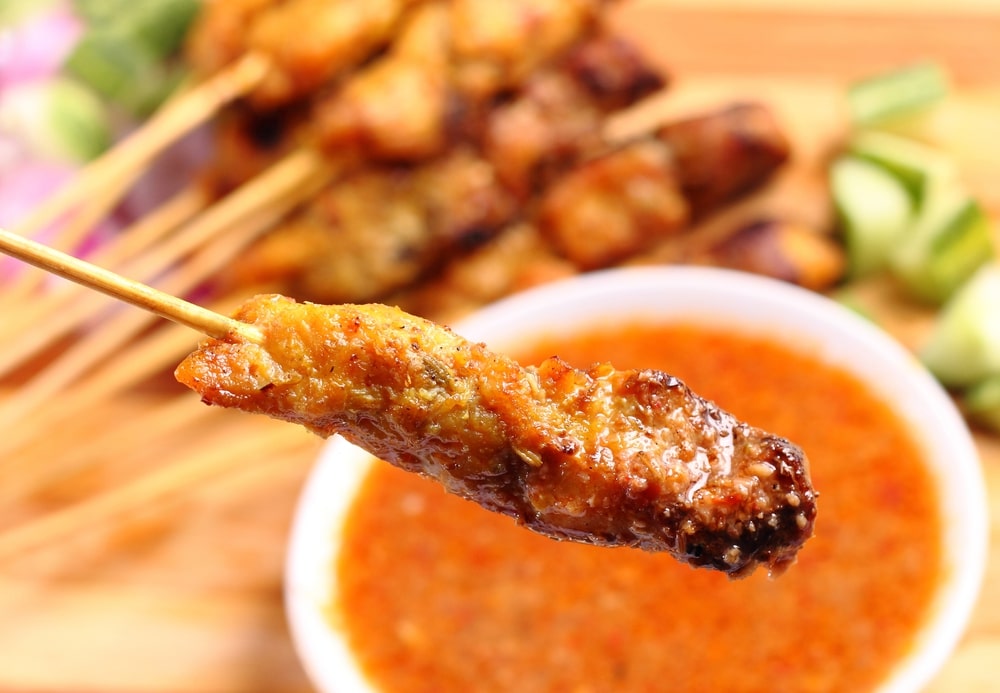Embark on a tantalizing culinary adventure with our authentic chicken satay recipe, a delectable dish that embodies the vibrant flavors of Southeast Asia. Chicken satay, a beloved street food and cultural icon, tantalizes taste buds with its succulent chicken skewers marinated in a symphony of spices and grilled to perfection.
Accompanied by a rich and savory peanut sauce, this dish promises an unforgettable gastronomic experience.
In this comprehensive guide, we’ll delve into the intricacies of creating authentic chicken satay, exploring the key ingredients, preparation techniques, and presentation secrets. Whether you’re a seasoned chef or a culinary novice, our step-by-step instructions and insightful tips will empower you to recreate this Southeast Asian delicacy in the comfort of your own kitchen.
Introduction
An authentic chicken satay recipe embodies the culinary traditions and cultural heritage of Southeast Asia. It is a beloved dish that transcends geographical boundaries, uniting people across cultures with its tantalizing flavors and aromas.
Chicken satay holds a significant place in the culinary tapestry of the region, often gracing festive gatherings, street food stalls, and family tables. Its origins can be traced back to Indonesia, where it is believed to have originated as a royal dish served at courtly banquets.
Key Ingredients and Flavors
The key ingredients in an authentic chicken satay recipe are carefully selected to create a harmonious balance of flavors. Chicken is the primary ingredient, typically cut into small pieces and marinated in a blend of aromatic spices. The marinade is a culinary masterpiece in itself, often comprising a symphony of flavors such as turmeric, coriander, cumin, and garlic.
Once marinated, the chicken pieces are skewered and grilled over an open flame or charcoal. This grilling process infuses the chicken with a smoky, charred flavor that complements the aromatic marinade. The result is a tender, juicy, and flavorful satay that is irresistible to food lovers.
Ingredients

The authentic chicken satay recipe requires a harmonious blend of ingredients that contribute to its distinct flavors and textures.
Chicken: The foundation of the satay is tender chicken, typically cut into small, bite-sized pieces. Chicken breast or thigh meat is suitable, providing a lean yet flavorful base.
Marinade
The marinade is crucial for infusing the chicken with a complex array of flavors. It typically includes:
- Soy sauce: Adds umami and a touch of saltiness.
- Coconut milk: Rich and creamy, it tenderizes the chicken and adds a subtle sweetness.
- Turmeric: Provides a vibrant yellow hue and earthy notes.
- Cumin: Imparts a warm, nutty flavor.
- Coriander: Adds a citrusy and slightly floral aroma.
- Garlic and ginger: Essential aromatic ingredients that enhance the overall flavor profile.
Skewers
Traditionally, bamboo skewers are used to thread the marinated chicken pieces. They provide support and allow for even cooking over an open flame or grill.
Peanut Sauce
The rich and savory peanut sauce is a key element of chicken satay. It is typically made from:
- Peanut butter: Forms the creamy base of the sauce, providing a nutty and earthy flavor.
- Coconut milk: Adds a touch of sweetness and creaminess.
- Soy sauce: Balances the sweetness with a hint of saltiness.
- Lime juice: Brightens the sauce with its citrusy acidity.
- Chilli peppers: Add heat and depth of flavor, adjusting to personal preference.
- Garlic and ginger: Provide a subtle aromatic undertone.
Variations
While the classic ingredients remain the same, variations in the marinade and peanut sauce can add unique twists to the recipe.
For example, you can substitute lemongrass for turmeric in the marinade for a more citrusy flavor. Alternatively, you can add chopped peanuts to the peanut sauce for added texture.
Preparation

Preparing chicken satay involves a meticulous process of marinating, skewering, and grilling the chicken to achieve the perfect texture and flavor. Let’s delve into the detailed steps to master this culinary art.
Marinating
To begin, create a flavorful marinade by combining soy sauce, brown sugar, garlic, ginger, and spices. Immerse the chicken pieces in the marinade, ensuring they are fully coated. Allow them to marinate for at least 30 minutes, or preferably overnight, to allow the flavors to penetrate deeply.
Skewering
Once the chicken is well-marinated, it’s time to skewer it. Use bamboo skewers and thread the chicken pieces onto them, ensuring they are evenly spaced. Avoid overcrowding the skewers to allow for even cooking.
Grilling
Heat a grill or barbecue to medium-high heat. Place the skewers on the grill and cook for 10-12 minutes, turning them frequently to ensure even grilling. Brush the chicken with the remaining marinade during grilling to enhance its flavor.
Marinade
The marinade plays a crucial role in infusing flavor and tenderness into the chicken satay. It not only adds a tantalizing taste but also helps break down the muscle fibers, resulting in a succulent and juicy texture.
Marinade Recipes
There are countless marinade recipes available, each offering a unique flavor profile. Here are a few popular variations:
-
-*Traditional Javanese Marinade
A blend of sweet soy sauce, kecap manis, garlic, shallots, and spices like turmeric and coriander.
-*Spicy Peanut Marinade
Combines the richness of peanut butter with the heat of chili peppers, ginger, and garlic.
-*Coconut Milk Marinade
A creamy and aromatic marinade made with coconut milk, lemongrass, and galangal.
Marinating Techniques
To ensure optimal absorption of the marinade, follow these techniques:
-
-*Slash the Chicken
Make shallow cuts into the chicken to create pockets for the marinade to penetrate.
-*Thoroughly Mix
Combine the marinade ingredients and coat the chicken evenly.
-*Refrigerate
Allow the chicken to marinate for at least 30 minutes, preferably overnight. The longer the marinating time, the deeper the flavor will be.
-*Flip the Chicken
Periodically turn the chicken in the marinade to ensure all sides are evenly coated.
Skewering
Skewering is a crucial step in preparing chicken satay, as it ensures even cooking and prevents the chicken from falling off during grilling or roasting.
There are two main types of skewers used for chicken satay: wooden and metal. Wooden skewers are more traditional and can be soaked in water before use to prevent burning. Metal skewers are more durable and reusable but can transfer heat more quickly, so care must be taken to avoid overcooking the chicken.
Skewering Techniques
To skewer the chicken evenly, use a sharp knife to cut the chicken into bite-sized pieces. Thread the chicken onto the skewers, alternating between pieces of light and dark meat for a balanced flavor. Push the chicken pieces close together, but not so tightly that they overlap, to allow for proper airflow during cooking.
Preventing Chicken from Falling Off
To prevent the chicken from falling off the skewers, use a few simple techniques:
- Marinate the chicken for at least 30 minutes before skewering. This will help tenderize the chicken and make it more likely to stick to the skewers.
- Skewer the chicken in a criss-cross pattern. This will create more contact points between the chicken and the skewer, making it less likely to slip off.
- Use a combination of wooden and metal skewers. The wooden skewers will help to hold the chicken in place, while the metal skewers will conduct heat more efficiently.
Grilling
To achieve perfectly grilled chicken satay, it’s crucial to maintain the right temperature and employ proper grilling techniques. Let’s delve into the optimal conditions and essential steps involved.
Temperature Control
The ideal grilling temperature for chicken satay ranges between 375°F (190°C) and 400°F (204°C). This temperature range ensures the chicken cooks evenly without burning or drying out.
Grilling Techniques
- Indirect Grilling: Place the chicken skewers over the indirect heat zone of the grill, away from the direct flames. This method helps prevent the chicken from burning while allowing it to cook thoroughly.
- Basting: During grilling, baste the chicken skewers with the remaining marinade to keep them moist and enhance their flavor.
- Turning Regularly: Rotate the skewers frequently to ensure even cooking on all sides.
- Checking Doneness: Insert a meat thermometer into the thickest part of the chicken. The internal temperature should reach 165°F (74°C) to ensure it’s fully cooked.
Preventing Burning or Drying Out
- Avoid Overcrowding: Grill the skewers in batches to prevent overcrowding and ensure proper heat circulation.
- Use a Grill Basket: If possible, place the skewers in a grill basket to prevent them from falling through the grates.
- Keep the Grill Clean: Clean the grill grates before grilling to prevent food from sticking and burning.
Peanut Sauce
No chicken satay is complete without its traditional peanut sauce. This rich and flavorful sauce is the perfect complement to the tender chicken, and it’s surprisingly easy to make.
The key ingredients in peanut sauce are, of course, peanuts. But don’t just use any peanuts; for the best flavor, use roasted peanuts. The roasting process brings out the natural sweetness and nuttiness of the peanuts, which gives the sauce its distinctive flavor.
Tips for Achieving the Perfect Consistency
- Start with a smooth peanut butter. This will help the sauce achieve a creamy consistency.
- Add coconut milk or water to thin the sauce to your desired consistency.
- If you want a spicier sauce, add some chili paste or Sriracha.
- For a sweeter sauce, add some honey or brown sugar.
Presentation
Chicken satay is traditionally served on skewers, hot off the grill. The skewers are typically arranged on a platter or banana leaf, garnished with fresh herbs like cilantro or parsley. The peanut sauce is served on the side, allowing diners to dip their satay as they eat.Garnishes
and accompaniments play an important role in the presentation of chicken satay. Fresh herbs add a vibrant color and freshness to the dish, while pickled vegetables or cucumbers provide a tangy contrast to the rich peanut sauce. Sliced onions or scallions can also be added for a bit of crunch and extra flavor.
Creative Presentations
For a more creative and visually appealing presentation, you can try arranging the chicken satay in different ways. One option is to create a “satay tower” by stacking the skewers vertically on a plate. You can also try skewering the chicken in different patterns, such as a spiral or a zigzag.Another
way to make your chicken satay more visually appealing is to use different colored vegetables. For example, you could use red bell peppers, yellow onions, and green zucchini to create a colorful skewer. You could also try marinating the chicken in different flavors, such as teriyaki or honey mustard, to add variety to the dish.
Closing Summary
As you savor each bite of your homemade chicken satay, let the aromatic blend of spices transport you to the bustling streets of Southeast Asia. This dish not only nourishes your palate but also offers a glimpse into the rich culinary heritage of the region.
Experiment with different marinades, skewering techniques, and presentation styles to make this recipe your own. Remember, the true essence of authentic chicken satay lies in the joy of sharing it with loved ones and creating lasting memories around the table.
FAQs
Can I substitute beef or pork for chicken in this recipe?
While beef or pork can be used as alternative proteins, the traditional chicken satay recipe calls for chicken. The flavors and textures of beef or pork may alter the authentic taste and experience.
What type of skewers are best for chicken satay?
Bamboo skewers are the preferred choice for chicken satay. They are sturdy enough to hold the chicken securely during grilling and impart a subtle smoky flavor to the meat.
How can I achieve the perfect doneness for my chicken satay?
To ensure your chicken satay is cooked to perfection, grill it over medium heat until the internal temperature reaches 165°F (74°C) as measured with a meat thermometer.
Can I make the peanut sauce ahead of time?
Yes, the peanut sauce can be made up to 2 days in advance. Store it in an airtight container in the refrigerator and bring it to room temperature before serving.
